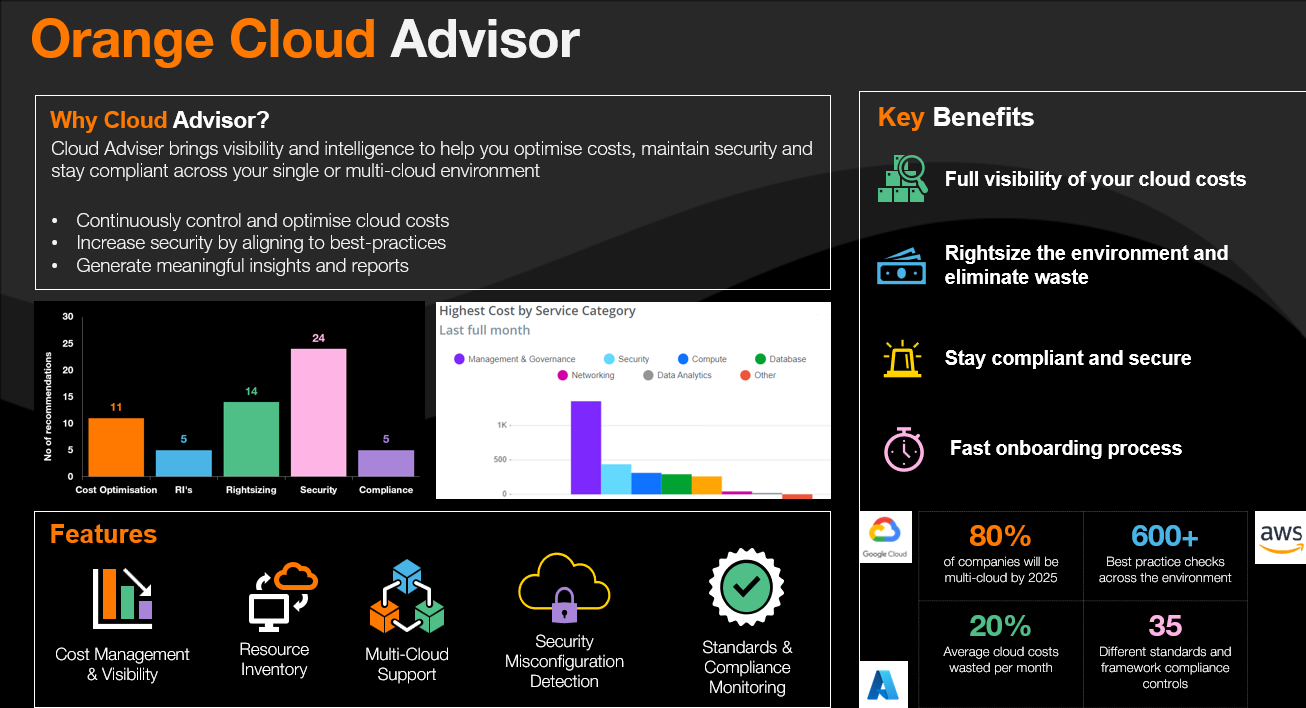If the above sounds all too familiar, worry not, as you aren’t alone.
Many companies are wrestling with these exact problems, and solving them using traditional methods within your organization might not give you the expected results. As businesses increasingly migrate to the cloud, managing and reducing cloud costs has become paramount. Without proper oversight, cloud expenditures can spiral out of control, impacting the bottom line.
The good news is that Orange Business offers practical solutions to optimize your cloud spending by leveraging our FinOps and cloud architecture expertise. We help enterprises navigate and manage challenges and reduce cloud costs effectively
Understanding the cloud cost landscape
Cloud computing offers incredible flexibility, scalability and innovation, but it also comes with its own set of financial challenges. Imagine driving a high-performance sports car—it’s thrilling, but if you’re not careful, the costs can get out of hand. This is where a structured approach like FinOps comes into play, providing the financial management framework that you need to stay on track.
Key strategies to managing and reducing cloud costs:
1. Establish a robust cloud cost governance framework
Think of cloud cost governance as setting the rules of the road for your cloud journey. It’s about making sure that everyone knows their roles and responsibilities, so there’s no confusion about who’s in charge of what. You will want to set budget limits – which is somewhat like setting a speed limit to prevent speeding. Regular audits are your pit stops, giving you a chance to check that everything is running smoothly, to identify anomalies and opportunities for savings, and to adjust where needed.
Actionable takeaway: Assemble a cross-functional team, including finance, operations and engineering, to regularly review cloud spending and enforce budget limits. Set up automated alerts for budget overages to keep everything under control.
2. Optimize resource utilization
Imagine you’re packing for a trip—do you really need that extra pair of shoes or that bulky sweater? In the cloud world, right sizing your resources can have the same analogy as packing efficiently. Regularly review and adjust the size of your cloud resources so you are only paying for what you need. Therefore, just like only turning on the air conditioning when it’s hot, auto-scaling ensures you’re only using resources when they’re needed – during peak and off-peak times. Even better, take advantage of pricing models such as spot instances for non-critical workloads and reserved instances for predictable, long-term needs.
Actionable takeaway: Schedule regular audits to find under-utilized resources and right-size your cloud instances. Implement auto-scaling policies to match resource allocation with real-time demand, minimizing waste.
3. Leverage cost management tools
You wouldn’t drive without a dashboard to keep track of your speed and fuel, right? The same goes for cloud cost management. Tools like AWS Cost Explorer and Azure Cost Management act as your dashboard, giving you visibility into your spending. And if you’re managing multiple clouds, consider using a third-party tool like Cloud Advisor with cloud optimization features and governance to keep everything in check.
Actionable takeaway: Integrate native cloud provider tools to monitor your spending. For a comprehensive view, consider third-party solutions like Cloud Advisor mentioned above that offer advanced features for multi-cloud management.
4. Implement chargeback and showback models
Accountability is key to keeping costs in line. Think of chargeback as making each department or team pay for their own gas—suddenly, everyone is a lot more mindful of how much they are consuming! Showback is a great starting point, giving teams a view of their costs without the immediate financial hit, helping them understand their consumption patterns.
Actionable takeaway: Start with a showback model to educate teams on their cloud usage. Then, transition to a chargeback model to create financial accountability and encourage cost-efficient behavior across departments.
5. Adopt a culture of cost awareness
Creating a culture of cost awareness is like making sure everyone on your road trip knows the route and how to read the map. Regular training sessions can keep everyone informed about the best practices for cost management and implications of their usage. And just like rewarding your kids for good behavior on a long drive, recognize and reward teams that actively reduce cloud costs or demonstrate innovation in managing their resources.
Actionable takeaway: Conduct regular training sessions to promote cost-efficient development practices. Recognize and reward teams that actively reduce cloud costs, fostering a culture of continuous cost awareness.
6. Regularly review and refine
The cloud environment is constantly changing—it’s like driving in a city where the streets are always upgraded or branched out with new routes. To stay on course, you need to continuously monitor your strategy and adjust as new services and pricing models come into play.
Actionable takeaway: Set up quarterly or bi-annual reviews of your cloud cost strategy to adapt to new services and pricing models. Establish continuous monitoring to quickly address any anomalies in cloud spending.
Emerging trends in cloud cost management
Artificial Intelligence (AI) and Machine Learning (ML) in cloud cost management
AI and ML are like having smart co-pilots on your cloud journey. These technologies analyze vast amounts of data to predict your next move and spending trends, whether it’s scaling up resources before a big demand spike or cutting back on unused services. They help you stay ahead of the curve, so you’re always one step ahead when it comes to managing costs.
Actionable takeaway: Implement AI-driven tools to predict usage patterns and automate resource optimization. Regularly review ML-generated insights to adjust your cloud strategy for maximum efficiency.
Sustainability and Green Cloud Computing
Sustainability in cloud computing is like choosing an eco-friendly car—it’s not just about saving money on fuel, but also about reducing your carbon footprint. By optimizing your cloud usage whether with leveraging energy-efficient hardware or adopting serverless architectures, you can cut down on both costs and energy consumption, making your cloud strategy more environmentally friendly while contributing towards sustainability goals.
Actionable takeaway: Audit your cloud infrastructure for energy-efficiency and consider migrating to more sustainable services. Align your cost management goals with sustainability initiatives to achieve both financial and environmental benefits.
Conclusion: our solution
We present to you Orange Cloud Advisor:

Its features include:
- 600+ best practice checks across cost management, security and compliance, utilization, performance and availability
- Cost optimization: eliminate waste and maximize investment
- Utilization and inventory: resource monitoring, optimization and assessment
- Security monitoring: total compliance – full mappings of best practice checks to 30+ compliance frameworks and standards like CIS, NIST 800-53, PCI and HIPAA
- Automation: remediation and policy enforcement with a “fix now” feature
- Multi-cloud support
Real world use cases
While there are numerous examples of enterprises realizing significant savings through our FinOps approach, automated with the help of Cloud Advisor, I'd like to highlight two recent successes. One being a mining organization and the other being a health and security services company. Both were able to save between 20% and 30% of their monthly costs using our managed services team, powered by Orange Cloud Advisor. These cases underscore the immediate and tangible benefits of adopting a FinOps framework tailored to different organizational needs.
Learn more about Orange Cloud Advisor through a free demo/POCs for customers billing US$50k per month.

Rahul Koul is a senior cloud and DC specialist at Orange Business India with over a decade of experience in leading digital transformation strategies. He is committed to designing cloud-centric solutions, leading transformation programs and maintaining relationships with stakeholders with strong expertise in cloud services, Gen AI, automation, storage and customer management. Rahul also enjoys playing sports, especially adventure sports, reading and traveling.